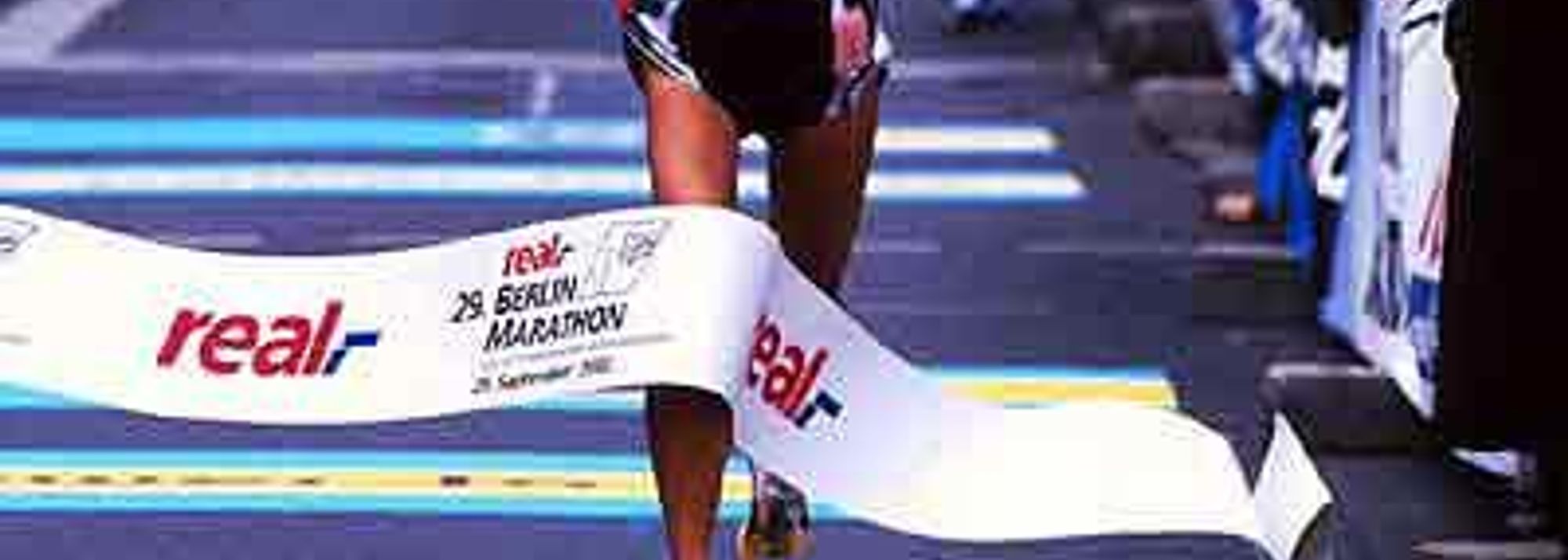Naoko Takahashi wins 2002 real-Berlin Marathon (© Victah Sailer)
A day before New Year’s Eve Horst Milde, the director of the Real Berlin Marathon, announced some major changes concerning the race, which will have a jubilee edition on 28th September 2003. For marathon runners the news is like a New Year’s fireworks display. The finish of the 30th Real Berlin Marathon will be at the Brandenburg Gate, Germany’s most famous landmark. Runners finishing the race will run through the gate and then for another 300 metres straight into the finish. The start will be just a bit further down the road on Strasse des 17 Juni. So television pictures will have the Brandenburg Gate in the background at both, the start and the finish.
Since the race was moved from the Berlin woods (Grunewald) into the city in 1981 the finish had been on Kurfürstendamm until 2000. It was only for the last two years that it had been slightly moved backwards into Tauentzienstrasse.
Ironically, the new starting area will be something of a step back in time for the organisers and some runners. In the second half of the 80’s, the Marathon was started at almost the same point as it will be on 28th September 2003. The background then of course included the Berlin Wall.
For a marathon in Germany Berlin’s the new finish could not be more spectacular. Since 1990 the start of the race had been on Straße des 17. Juni, but runners ran in the other direction towards Brandenburg Gate. The tourist attraction was reached after about two miles.
“With our new course we will present Berlin to the world”, race organiser Horst Milde said. While the new route has kept the sights of the former course like Kurfürstendamm with the Kaiser-Wilhelm-Gedächtniskirche, there are more landmarks included now: The Bundeskanzleramt (seat of the German chancellor), the Reichstag, which houses the German parliament or Friedrichstrasse with the famous Checkpoint Charlie are some examples.
As organisers expect a much higher interest in their race, they have again raised the entry limit by about ten percent. 35,000 runners will be allowed to compete. Entries will be accepted through the internet from the beginning of the new year until the limit is reached (www.berlin-marathon.com). Because of Berlin’s wide streets the course is generally regarded to be suitable for maybe 50,000 runners. “But we want to make sure that we can keep our high standard of organisation for the benefit of every runner. That is why we raise the limit by just a couple of thousand starters from year to year”, Horst Milde explains.
There is also good news for the serious and elite runners: the new course will be as flat and fast as the old one was. It was in Berlin that Naoko Takahashi (JPN) became the first woman to break the 2:20 barrier. In 2001 the Olympic Champion ran 2:19:46. Two other world best performances had been run in Berlin in recent years: Tegla Loroupe (KEN) won the race in 2:20:43 (1999) and Ronalda da Costa (BRA) still holds the men’s course record with 2:06:05 (1998).
See the new course details at the organisers web site: (www.berlin-marathon.com).



